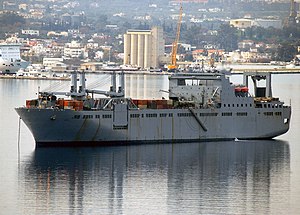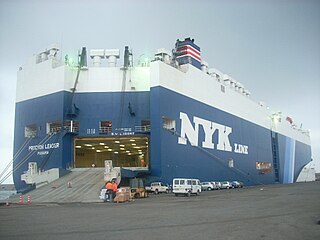
Vehicle cargo ship is a model of United States Navy ship used for the prepositioning of Army vehicles. An example of this is the USNS Bob Hope (T-AKR-300), the lead ship of her class.

Vehicle cargo ship is a model of United States Navy ship used for the prepositioning of Army vehicles. An example of this is the USNS Bob Hope (T-AKR-300), the lead ship of her class.

A missile is an airborne ranged weapon capable of self-propelled flight aided usually by a propellant, jet engine or rocket motor.

A watercraft or waterborne vessel is any vehicle designed for travel across or through water bodies, such as a boat, ship, hovercraft, submersible or submarine.

A dock landing ship is an amphibious warfare ship with a well dock to transport and launch landing craft and amphibious vehicles. Some ships with well decks, such as the Soviet Ivan Rogov class, also have bow doors to enable them to deliver vehicles directly onto a beach. Modern dock landing ships also operate helicopters.

A diesel–electric transmission, or diesel–electric powertrain, is a transmission system for vehicles powered by diesel engines in road, rail, and marine transport. Diesel–electric transmission is based on petrol–electric transmission, a transmission system used for petrol engines.

The SEAL Delivery Vehicle (SDV) is a crewed submersible and a type of swimmer delivery vehicle used to deliver United States Navy SEALs and their equipment for special operations missions. It is operated by SEAL Delivery Vehicle Teams.

Landing Ship, Tank (LST), or tank landing ship, is the naval designation for ships first developed during World War II (1939–1945) to support amphibious operations by carrying tanks, vehicles, cargo, and landing troops directly onto a low slope beach with no docks or piers. The shallow draft and bow doors and ramps enabled amphibious assaults on almost any beach.

A bulkhead is an upright wall within the hull of a ship, within the fuselage of an airplane, or a car. Other kinds of partition elements within a ship are decks and deckheads.

The Italian Navy is the navy of the Italian Republic. It is one of the four branches of Italian Armed Forces and was formed in 1946 from what remained of the Regia Marina after World War II. As of August 2014, the Italian Navy had a strength of 30,923 active personnel, with approximately 184 vessels in service, including minor auxiliary vessels. It is considered a multiregional and a blue-water navy.

A casemate is a fortified gun emplacement or armored structure from which guns are fired, in a fortification, warship, or armoured fighting vehicle.

Roll-on/roll-off ships are cargo ships designed to carry wheeled cargo, such as cars, motorcycles, trucks, semi-trailer trucks, buses, trailers, and railroad cars, that are driven on and off the ship on their own wheels or using a platform vehicle, such as a self-propelled modular transporter. This is in contrast to lift-on/lift-off (LoLo) vessels, which use a crane to load and unload cargo.

The M242 Bushmaster chain gun is a 25 mm (25×137mm) single-barrel chain-driven autocannon. It is used extensively by the U.S. military, such as in the Bradley fighting vehicle, as well as by other NATO members and some other nations in ground combat vehicles and various watercraft. Hughes Helicopters in Culver City, California, was the original designer and manufacturer. As of 2019, Northrop Grumman Innovation Systems produces the gun.

A deep-submergence rescue vehicle (DSRV) is a type of deep-submergence vehicle used for rescue of personnel from disabled submarines and submersibles. While DSRV is the term most often used by the United States Navy, other nations have different designations for their equivalent vehicles.

A wet sub is a type of underwater vehicle, either a submarine or a submersible, that does not provide a dry environment for its occupants. It is also described as an underwater vehicle where occupants are exposed to ambient environment during operations. The watercraft is classified as medium-sized or small vessel. This type of submarine differs from other underwater personal transport devices by the fact that it has a hull around it and it is not a "bare bones" design.

A submarine rescue ship is a surface support ship for submarine rescue and deep-sea salvage operations. Methods employed include the McCann Rescue Chamber, deep-submergence rescue vehicles (DSRV's) and diving operations.

The Submarine Rescue Diving Recompression System (SRDRS) is a remotely operated underwater vehicle and its associated systems intended to replace the Mystic class deep submergence rescue vehicle as a means of rescuing United States Navy submarine crew members. Based on the Royal Australian Navy Submarine rescue vehicle Remora, the system is capable of rapidly deploying to a designated location, mounting to a vessel of opportunity, detecting and preparing the area around a downed submarine and submerging to depths of up to 2,000 feet (610 m) to retrieve members of its crew. The SRDRS then allows for the decompression of the crew.

The SeaFox is an anti-mine Unmanned underwater vehicle (UUV) manufactured by German company Atlas Elektronik. It is designed to locate and destroy ground and moored mines. There are three versions, including a training version. The orange SeaFox-I "inspection" variant has sonar and an Inertial navigation system, and the black SeaFox-C "combat" round also has a 1.4 kilograms (3.1 lb) shaped charge warhead. The system is in service with eleven navies. The SeaFox is an advanced design of an Expendable Mine Disposal Vehicle or EMDV. It has a low life cycle cost as it has low running and replacement costs. Its main targets are sea mines that pose a danger to vessels. It communicates with the ship via a fiber-optic cable. The SeaFox uses a custom launch and retrieval system, that may be fitted to a variety of ships, boats or even helicopters. It can be used for a range of tasks such as conduct damage estimation, route surveys, maritime boundary control, intelligence and harbor surveillance missions.

A landing craft vehicle personnel or landing craft, vehicle, personnel (LCVP) is any of a variety of amphibious landing craft designed to transport troops or armoured vehicles from ship to shore during amphibious landings.

SRV-300 is a deep-submergence rescue vehicle that is rated to dive up to 300 m (980 ft). It was built by DRASS (Livorno) for the Marina Militare, and is capable of descending to 300 metres (980 ft) carrying 12 passengers in addition to crew. SRV-300 is hosted by Anteo, berthed at La Spezia.